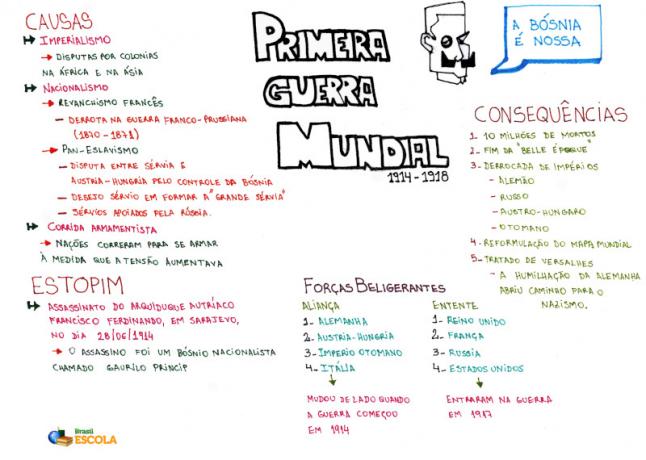The years leading up to World War I were not marked by any conflict between European nations. However, between the end of the 19th century and the beginning of the 20th century, the main nations involved in the imperialist disputes carried out a great arms race. Warfare technology underwent great advances at that time, and most of these weapons were tested in colonial possessions spread across the Asian and African continents.
The larger imperialist powers, such as England and France, used weapons to contain the revolts in their zones of imperialist domination. On the other hand, Italy and Germany – which had less wealthy domains – also participated in this war race with the objective of seeking new domains that would meet their economic ambitions. The expansion of the great powers' arsenal did not directly cause the war, but set the stage for the struggle.
Before 1914, European nations forged a large number of alliances that polarized economic disputes between nations. In the year 1882, Germany, the Austro-Hungarian Empire and Italy formed the so-called Triple Alliance. This agreement established that if one of the countries declared war, the others involved agreed to remain neutral. Beyond that point, other military issues were pre-established.
Mind Map: World War I

*To download the mind map in PDF, Click here!
If the French attacked Italy, Austrians and Germans should support Italy in a likely confrontation. If Germany were the victim of a French military invasion, only Italy would be forced to militarily support the Germans. Finally, if any of those involved in this treaty were confronted by two European nations, the others involved would have to support the ally with armies and arms.
Do not stop now... There's more after the advertising ;)
These agreements that foresaw a series of hypothetical conflicts, in fact, can be seen as a consequence of the disputes that occurred during the period. In Africa, the Germans sought to control markets previously dominated by the British. The economic and colonial pressure exerted by Germany forced England to break its long isolation from France, until then its biggest commercial competitor.
In 1904, Entente Cordial signed a first agreement between England and France. According to this first treaty, England would have complete freedom of economic exploration in the region of Egypt, while the French would have their interests guaranteed in Morocco. Germany did not recognize these agreements establishing resistance to French domination in Morocco. Between 1905 and 1911, small conflicts took place in the regions of Agadir and Tangier.
On the Asian continent, France and England disputed control of positions in territories of present-day Thailand. At the same time, the British had problems with Russian interests in economic exploitation of regions in the Middle East, Tibet and Central Asia. In 1907, French diplomatic intermediation managed to balance disputes between Russians and British.
The agreement between these three nations made it possible to sign the Triple Entente. This alliance established a process of political, military and economic polarization between the great European powers. In this context, the so-called “armed peace” is instituted, a diplomatic balance that could break down at the slightest conflict that could justify the direct struggle between the two formed alliances. That's when, in 1914, a terrorist incident in the Balkans sparked the historically fostered rivalries.
By Rainer Sousa
Graduated in History
*Mental Map by Daniel Neves
Graduated in History
Would you like to reference this text in a school or academic work? Look:
SOUSA, Rainer Gonçalves. "Alliances for the First World War"; Brazil School. Available in: https://brasilescola.uol.com.br/historiag/aliancas.htm. Accessed on June 27, 2021.

